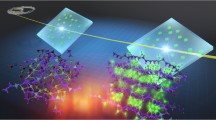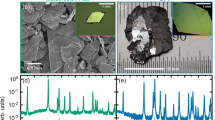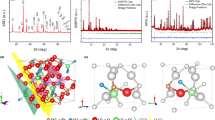Abstract
The properties of ceramic materials are strongly influenced by the presence of ultradilute impurities (dopants). Near-edge X-ray absorption fine structure (NEXAFS) measurements using third-generation synchotron sources can be used to identify ultradilute dopants, provided that a good theoretical tool is available to interpret the spectra. Here, we use NEXAFS analysis and first-principles calculations to study the local environments of Ga dopants at levels of 10 p.p.m in otherwise high-purity MgO. This analysis suggests that the extra charge associated with substitutional Ga on a Mg site is compensated by the formation of a Mg vacancy. This defect model is then confirmed by positron lifetime measurements and plane-wave pseudopotential calculations. This powerful combination of techniques should provide a general method of identifying the defect states of ultradilute dopants in ceramics.
This is a preview of subscription content, access via your institution
Access options
Subscribe to this journal
Receive 12 print issues and online access
$259.00 per year
only $21.58 per issue
Buy this article
- Purchase on Springer Link
- Instant access to full article PDF
Prices may be subject to local taxes which are calculated during checkout




Similar content being viewed by others
References
Rehr, J.J. & Albers, R.C. Theoretical approach to x-ray absorption fine structure. Rev. Mod. Phys. 72, 621–654 (2000).
Gauthier, C., Solé, V.A., Signorato, R., Goulon, J. & Moguiline, E. The ESRF bemline ID26: X-ray absorption in ultra dilute sample. J. Syncrotron Rad. 6, 164–166 (1999).
Ofuchi, H., Kubo, T., Tabuchi, M., Takahei, K. & Takeda, Y. Local structuures around Er atoms in GaAs:Er,O studied by fluorescence EXAFS and photoluminescence. Microelectron. Eng. 51–52, 715–720 (2000).
Mo, S.-D. & Ching, W.Y. Ab initio calculation of the core–hole effect in the electron energy-loss near-edge structure. Phys. Rev. B 62, 7901–7909 (2000).
Mo, S.-D. & Ching, W.Y. X-ray absorption near-edge structure in alpha-quartz and stishovite: Ab initio calculation with core-hole interaction. Appl. Phys. Lett. 78, 3809–3811 (2001).
Tanaka, I. et al. Electron energy loss near-edge structures of cubic Si3N4 . Appl. Phys. Lett. 78, 2134–2136 (2001).
Ching, W.Y., Mo, S.-D., & Chen Y. Calculation of XANES/ELNES Spectra of All edges in Si3N4 and Si2N2O. J. Am. Ceram. Soc. 85, 11–15 (2002).
Xu, Y.-N., Mo, S.-D., Chen, Y. & Ching, W.Y. Core-exciton, valence exciton and the optical properties of Yttrium Alumina Garnet (Y3Al5O12). Phys. Rev. B 65, 235105 (2002).
Chiang, Y.-M., Birnie III, D. & Kingery, W.D. Physical Ceramics (Wiley, New York, 1997).
Krause-Rehberg, R. & Leipner, H.S. Positron Annihilation in Semi-conductors Defect Study (Springer, Berlin, 1999).
Kirkegaard, P., Eldrup, M, Mogensen O.E. & Pedersen, N.J. Program system for analysing positron lifetime spectra and angular correlation curves. Comput. Phys. Commun. 23, 307–335 (1981).
Kirkegaard, P. & Eldrup, M. Positronfit extended: A new version of a program for analysing position lifetime spectra. Comput. Phys. Commun. 7, 401–409 (1974).
Mizuno, M., Araki, H. & Shirai, Y. in Advances in Quantum Chemistry Vol. 42 (eds Sabin, J.R. & Brandas, E.) 109–126 (Academic, USA, 2003).
Monge, M.A., Pareja, R., Gonzalez, R. & Chen, Y. Metastable self-trapping of positrons in MgO. Phys. Rev. B 55, 243–249 (1997).
Segall, M.D. et al. First principles simulation: Ideas, illustrations and the CASTEP code. J. Phys. Cond. Matter 14, 2717–2743 (2002); The CASTEP program code was used: (Accelrys, San Diego, USA).
Vanderbilt, D. Soft self-consistent pseudopotentials in a generalized eigenvalue formalism. Phys. Rev. B 41, 7892–7895 (1990).
Oba, F, Nishitani, S.R., Isotani, S., Adachi, H. & Tanaka, I. Energetics of native defects in ZnO. J. Appl. Phys. 90, 824–828 (2001).
Tanaka, I., Tatsumi, K., Nakano, M., Adachi, H. & Oba, F. First-principles calculations of anion vacancies in oxides and nitrides. J. Am. Ceram. Soc. 85, 68–74 (2002).
Acknowledgements
Experimental support by T. Uruga, H. Tanida and T. Homma of JASRI/SPring-8 (synchotron radiation facility, Japan), under proposal No. 2002A0342-NX-np and helpful discussion with F. Oba and M. Yoshiya of Kyoto University are gratefully acknowledged. This work was supported by the Grant-in-Aid for Scientific Research on Priority Areas (No.751) and the 21st century COE program, both from the Ministry of Education, Culture, Sports, Science and Technology of Japan, and the international collaboration program from NEDO, Japan. W.Y.C. was supported by the US Department of Energy under grant number DE-FG02-84ER45170.
Author information
Authors and Affiliations
Corresponding author
Ethics declarations
Competing interests
The authors declare no competing financial interests.
Rights and permissions
About this article
Cite this article
Tanaka, I., Mizoguchi, T., Matsui, M. et al. Identification of ultradilute dopants in ceramics. Nature Mater 2, 541–545 (2003). https://doi.org/10.1038/nmat939
Received:
Accepted:
Published:
Issue Date:
DOI: https://doi.org/10.1038/nmat939
This article is cited by
-
Learning excited states from ground states by using an artificial neural network
npj Computational Materials (2020)
-
Data-driven approach for the prediction and interpretation of core-electron loss spectroscopy
Scientific Reports (2018)
-
An estimation of molecular dynamic behaviour in a liquid using core-loss spectroscopy
Scientific Reports (2013)
-
Atom-resolved imaging of ordered defect superstructures at individual grain boundaries
Nature (2011)
-
Theoretical ELNES spectra of Si-K, Si-L, N-K, and O-K edges of an intergranular glassy film model in β-Si3N4
Journal of Materials Science (2011)



